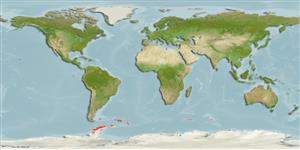Environment: milieu / climate zone / depth range / distribution range
Ecology
Marine; demersal; depth range 6 - 429 m (Ref. 11892). Polar; 53°S - 67°S, 75°W - 75°E
Southern Ocean: Scotia Arc and Heard Island. Also distributed in the South Atlantic, near the southern Shetland, southern Sandwich, southern Orkney Islands, and near South Georgia Island (Ref. 4883).
Length at first maturity / Size / Weight / Age
Maturity: Lm 37.7 range ? - ? cm
Max length : 55.0 cm TL male/unsexed; (Ref. 5179); common length : 40.0 cm TL male/unsexed; (Ref. 2121)
Dorsal spines (total): 6 - 8; Dorsal soft rays (total): 31 - 34; Anal soft rays: 31 - 34. Upper part of head and body irregularly spotted and blotched. Rarely with traces of darker cross-bars, young with irregular cross-bars, broken up into three or four series of alternating spots (Ref. 11892).
Body shape (shape guide): fusiform / normal.
Mature females may spawn for the first time from around 6-8 years of age (Ref. 71843).
Dewitt, H.H., P.C. Heemstra and O. Gon, 1990. Nototheniidae. p. 279-331. In O. Gon and P.C. Heemstra (eds.) Fishes of the Southern Ocean. J.L.B. Smith Institute of Ichthyology, Grahamstown, South Africa. (Ref. 5179)
IUCN Red List Status (Ref. 130435: Version 2025-1)
Threat to humans
Harmless
Human uses
Fisheries: minor commercial
Tools
Special reports
Download XML
Internet sources
Estimates based on models
Preferred temperature (Ref.
123201): -1.3 - 0.7, mean -0.6 °C (based on 36 cells).
Phylogenetic diversity index (Ref.
82804): PD
50 = 0.5312 [Uniqueness, from 0.5 = low to 2.0 = high].
Bayesian length-weight: a=0.00407 (0.00344 - 0.00482), b=3.24 (3.19 - 3.29), in cm total length, based on LWR estimates for this species (Ref.
93245).
Trophic level (Ref.
69278): 3.3 ±0.2 se; based on diet studies.
Resilience (Ref.
120179): Low, minimum population doubling time 4.5 - 14 years (Fec=21,699; tm=10).
Fishing Vulnerability (Ref.
59153): Moderate vulnerability (42 of 100).
🛈
Climate Vulnerability (Ref.
125649): Moderate to high vulnerability (46 of 100).
🛈
Nutrients (Ref.
124155): Calcium = 19.7 [11.5, 46.6] mg/100g; Iron = 0.384 [0.181, 0.754] mg/100g; Protein = 17.7 [15.5, 19.6] %; Omega3 = 0.329 [0.180, 0.572] g/100g; Selenium = 16.6 [7.0, 41.1] μg/100g; VitaminA = 12.4 [2.7, 59.6] μg/100g; Zinc = 0.497 [0.332, 0.747] mg/100g (wet weight); based on
nutrient studies.
